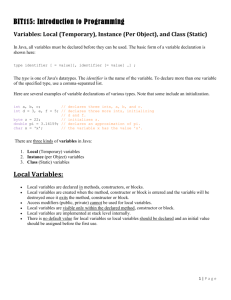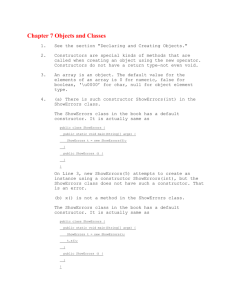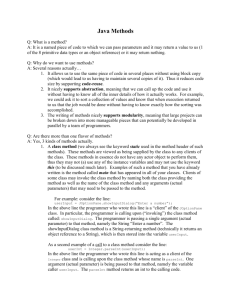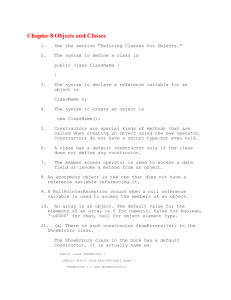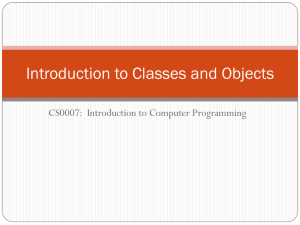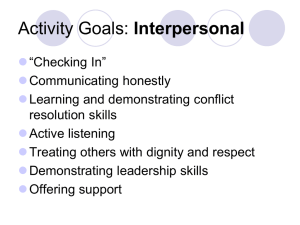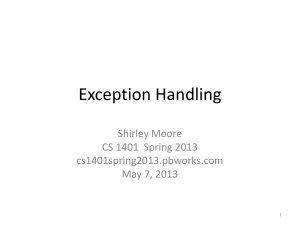javaClassConstructors2013
advertisement
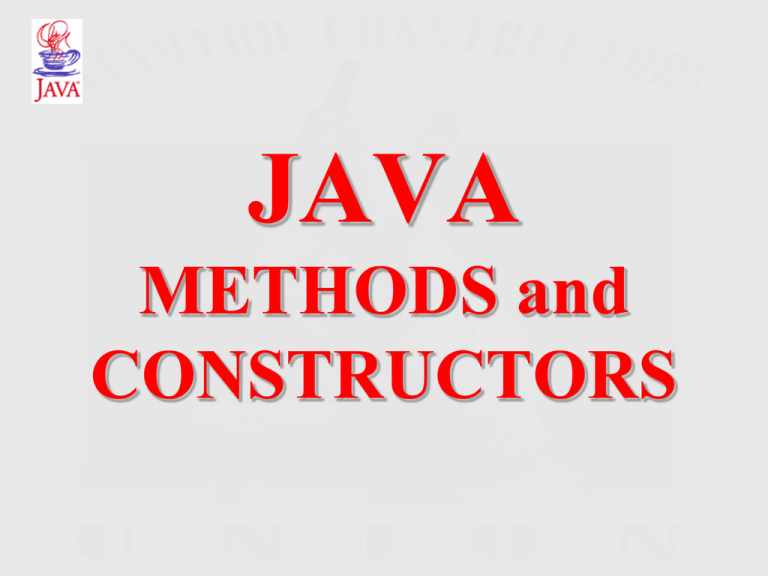
JAVA
METHODS and
CONSTRUCTORS
JAVA Classes
• The class is the fundamental concept in JAVA (and other
OOPLs)
• A class describes some data object(s), and the operations (or
methods) that can be applied to those objects
• Every object and method in Java belongs to a class
• Classes have data (fields) and code (methods) and classes
(member classes or inner classes)
• Static methods and fields belong to the class itself
• Non-static methods and fields belong to instances
2
An example of a class
Type it into Dr. Java and run it
Instance Variable
public class Person {
private String name;
private int age=-1;
Method
public Person() {name=“ “; age=0;}
public void birthday ( ) {
age++;
System.out.println (name +
“ is now “ + age);
}
}
3
Why didn’t it run?
What is missing from our Person class?
What kind of error did you get?
How can we fix it?
Create a main() in the Person class and
construct two people.
How old are they?
How do you make them older?
What might make this nicer?
4
Another Constructor
Add this to your Person class
// new constructor
public Person(int currAge)
{
this.age = currAge;
}
//existing constructor
public Person()
{
this.age = 0;
this.name = “ “;
}
5
Constructors
• Classes should define one or more constructors
• Their name is the same as the class name
• Constructors are differentiated by the number and types of
their arguments
– An example of overloading
• If you don’t define a constructor, a default one will be
created.
• Constructors automatically invoke the zero argument
constructor of their superclass when they begin
6
What Happens?
public static void main(String[] args)
{
Person priya = new Person();
Person rofael = new Person(16);
priya.birthday();
rofael.birthday();
}
void birthday ( ) {
age++;
System.out.println
(name +” is now “+ age);
}
7
What Happens?
public static void main(String[] args)
{
Person adam = new Person();
Person ali = new Person(16);
ali = adam;
ali.birthday();
}
8
What Happens?
public static void main(String[] args)
{
Person sruti = new Person();
Person noah = sruti;
Person case;
sruti = noah;
case.birthday();
noah.birthday();
}
9
What about the name?
Do we have any way to set the name instance
variable?
What do we need to do?
Create a new method:
public void setName( String nm)
{
this.name = nm;
}
10
Or we could create a new
constructor or two:
public Person( String nm)
{
this.name = nm;
}
public Person( String nm, int age)
{
this.name = nm;
this.age = 0;
}
11
Best Practice
Create methods to get and set every instance
variable.
Why?
private variables, public methods
We call them accessors and mutators,
or informally, getters and setters
Exception: instance variables that you don’t want
set by any other class
12
Methods, arguments and return values
• Java methods. General case:
returnType methodName ( arg1, arg2, … argN) {
methodBody
}
The return keyword exits a method optionally with a value
int storage(String s) {return s.length() * 2;}
boolean flag() { return true; }
float naturalLogBase() { return 2.718f; }
void nothing() { return; }
void nothing2() {}
13
Instance Variables
• Java instance variables. General case:
variableType variableName
•Can declare and initialize in one
statement or two
•String name;
name = “APCSA”;
•String name = “APCSA”;
•int age = -1;
14
Now What Happens?
public static void main(String[] args)
{
Person victor = new Person();
Person monica = new Person(“Victor”, 16);
victor.setName(“Monica”);
Monica.birthday();
}
15
What Happens?
public static void main(String[] args)
{
Person pooja = new Person();
Person ellen = new Person(“Pooja”);
ellen = pooja;
pooja.birthday();
}
16
What Happens?
public static void main(String[] args)
{
Person jasmin = new Person(“Jasmin”);
Person dima;
jasmin = dima;
dima = jasmin;
jasmin.setName();
jasmin.birthday();
}
17
Scoping
• Scope is determined by the placement of curly braces {}.
• A local variable defined within a scope is available only to the end of
that scope.
{
int x = 12;
/* only x available */
{
int q = 96;
/* both x and q available */
}
/* only x available */
/* q “out of scope” */
}
18
Scope of Objects
• Java objects don’t have the same lifetimes as
primitives.
• When you create a Java object using new, it hangs
around past the end of the scope.
• Here, the scope of variable s is delimited by the {}s
but the String object hangs around until GC’d
{
String s = new String("a string");
} /* end of scope */
19
The static keyword
• Java methods and variables can be declared static
• These exist independent of any object
• This means that a Class’s
– static methods can be called even if no objects of that
class have been created and
– static data is “shared” by all instances (i.e., one value per
class instead of one per instance
class StaticTest {static int i = 47;}
StaticTest st1 = new StaticTest();
StaticTest st2 = new StaticTest();
// st1.i == st2.i == 47
StaticTest.i++;
// or st1.I++ or st2.I++
// st1.i == st2.i == 48
20
Another Constructor example
public class Circle {
public static final double PI = 3.14159; // A constant
private double r;
// instance field holds circle’s radius
// The constructor method: initialize the radius field
public Circle(double r) { this.r = r; }
this.r refers to the r
field of the class
// Constructor to use if no arguments
public Circle() { r = 1.0; }
// The instance methods: compute values based on radius
public double circumference() { return 2 * PI * r; }
public double area() { return PI * r*r; }
}
21
Extending a class
• Class hierarchies reflect subclass-superclass relations among
classes.
• One arranges classes in hierarchies:
– A class inherits instance variables and instance methods from all of its
superclasses. Musical Instrument -> StringInst -> Viola
– You can specify only ONE superclass for any class.
• Something like multiple inheritance can be done via interfaces
(more on this later)
• What’s the superclass of a class defined without an extends
clause?
22
Extending a class
public class PlaneCircle extends Circle {
// We automatically inherit the fields and methods of Circle,
// so we only have to put the new stuff here.
// New instance fields that store the center point of the circle
private double cx, cy;
// A new constructor method to initialize the new fields
// It uses a special syntax to invoke the Circle() constructor
public PlaneCircle(double r, double x, double y) {
super(r);
// Invoke the constructor of the superclass, Circle()
this.cx = x;
// Initialize the instance field cx
this.cy = y;
// Initialize the instance field cy
}
// The area() and circumference() methods are inherited from Circle
// A new instance method that checks whether a point is inside the circle
// Note that it uses the inherited instance field r
public boolean isInside(double x, double y) {
double dx = x - cx, dy = y - cy;
// Distance from center
double distance = Math.sqrt(dx*dx + dy*dy); // Pythagorean theorem
return (distance < r);
// Returns true or false
}
}
23
Overloading, overwriting, and shadowing
• Overloading occurs when Java can distinguish two procedures with the
same name by examining the number or types of their parameters.
• Shadowing or overriding occurs when two procedures with the same
signature (name, the same number of parameters, and the same
parameter types) are defined in different classes, one of which is a
superclass of the other.
24
On designing class hierarchies
• If you find yourself using the phrase an X is a Y when describing the
relation between two classes, then the X class is a subclass of the Y class.
Inheritance
• If you find yourself using X has a Y when describing the relation between
two classes, then instances of the Y class appear as parts of instances of the
X class.
COMPOSITION
25
Data hiding and encapsulation
• Data-hiding or encapsulation is an important part
of the OO paradigm.
• Classes should carefully control access to their data
and methods in order to
– Hide the irrelevant implementation-level details so they
can be easily changed
– Protect the class against accidental or malicious damage.
– Keep the externally visible class simple and easy to
document
• Java has a simple access control mechanism to help
with encapsulation
– Modifiers: public, protected, private, and package
(default)
26
Getters and setters
• A getter is a method that extracts information from an instance.
– One benefit: you can include additional computation in a getter.
• A setter is a method that inserts information into an instance (also
known as mutators).
– A setter method can check the validity of the new value (e.g., between 1 and
7) or trigger a side effect (e.g., update a display)
• Getters and setters can be used even without underlying matching
variables
• Considered good OO practice
• Convention: for variable fooBar of type fbtype, define
– getFooBar()
– setFooBar(fbtype x)
27
package shapes;
// Specify a package for the class
public class Circle {
// The class is still public
// This is a generally useful constant, so we keep it public
public static final double PI = 3.14159;
protected double r;
Example
getters and setters
// Radius is hidden, but visible to subclasses
// A method to enforce the restriction on the radius
// This is an implementation detail that may be of interest to subclasses
protected checkRadius(double radius) {
if (radius < 0.0)
throw new IllegalArgumentException("radius may not be negative.");
}
// The constructor method
public Circle(double r) { checkRadius(r); this.r = r;}
// Public data accessor methods
public double getRadius() { return r; };
public void setRadius(double r) { checkRadius(r); this.r = r;}
// Methods to operate on the instance field
public double area() { return PI * r * r; }
public double circumference() { return 2 * PI * r; }
}
28
Abstract classes and methods
• Abstract vs. concrete classes
• Abstract classes can not be instantiated
public abstract class shape { }
• An abstract method is a method w/o a body
public abstract double area();
• (Only) Abstract classes can have abstract methods
• In fact, any class with an abstract method is
automatically an abstract class
29
public abstract class Shape {
public abstract double area(); // Abstract methods: note
public abstract double circumference();// semicolon instead of body.
}
Example
abstract class
public class Circle extends Shape {
public static final double PI = 3.14159265358979323846;
private double r;
// Instance data
public Circle(double r) { this.r = r; }
// Constructor
public double getRadius() { return r; }
// Accessor
public double area() { return PI*r*r; }
// Implementations of
public double circumference() { return 2*PI*r; } // abstract methods.
}
class Rectangle extends Shape {
private double w, h;
// Instance data
public Rectangle(double w, double h) {
// Constructor
this.w = w; this.h = h;
}
public double getWidth() { return w; }
// Accessor method
public double getHeight() { return h; }
// Another accessor
public double area() { return w*h; }
// Implementations of
public double circumference() { return 2*(w + h); } // abstract methods.
}
30
Assignment
• P3.4, page 126 – Write an Employee class with two
constructors and get/setName() and get/setSalary()
methods. Be sure to include a raiseSalary(double
byPercent) method. Also write a test program to
test your class.
31
